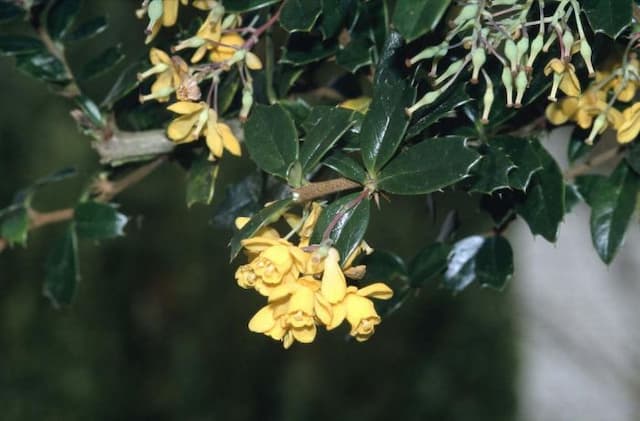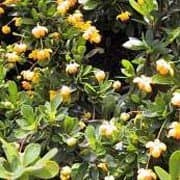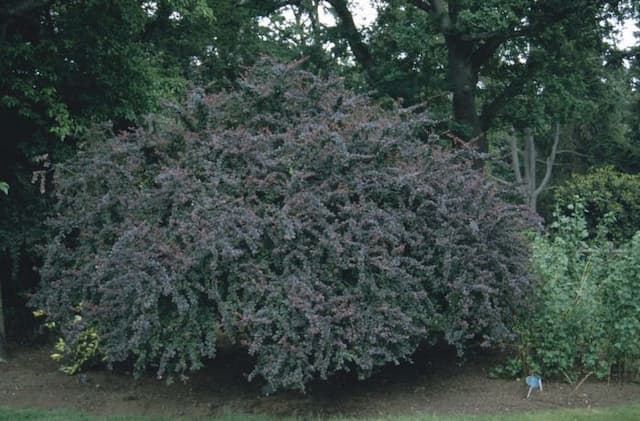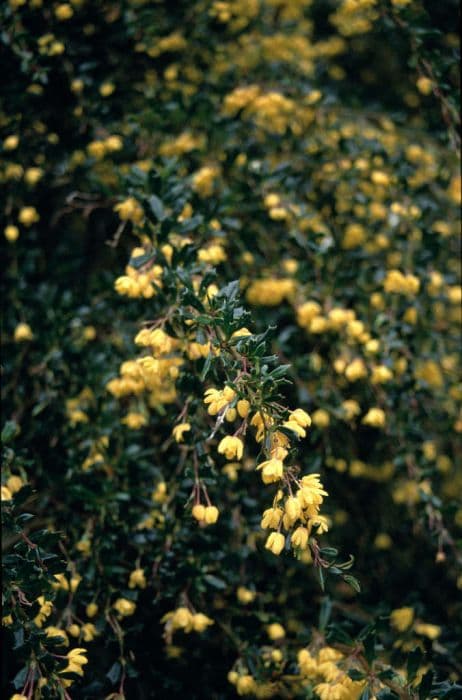Bishop's Hat Epimedium × omeiense 'Akame'

ABOUT
Epimedium × omeiense 'Akame', commonly known as Bishop's Hat, is a perennial plant known for its distinctive and ornamental foliage and flowers. The leaves of this variety have a unique heart-like shape with spiky edges, giving a jagged appearance. They emerge with a striking bronze-red tint in spring, which eventually turns to a rich green as they mature. The appeal of Bishop's Hat lies not only in its foliage but also in its flowers. The plant produces delicate sprays of small flowers that rise above the leaves on slender, wiry stems. Each flower has an intricate structure, often featuring a cupped shape with spurs that extend backwards, resembling a bishop's mitre, hence its common name. The blooms exhibit a mix of warm colors, typically a rich red or purplish-red, adding a splash of color to garden spaces in the blooming season. The texture and color contrast between the foliage and the blossoms of Bishop's Hat make it a popular choice for gardeners looking to add variety to their plantings. It is often prized for its resilience and the layered aesthetic it brings to garden compositions, making it a picturesque addition to shaded garden areas, where its colors can truly stand out against the green backdrop.
About this plant
 Names
NamesFamily
Berberidaceae.
Synonyms
Bishop's Hat, Fairy Wings, Horny Goat Weed, Barrenwort, Yin Yang Huo.
Common names
Epimedium × omeiense 'Akame'
 Toxicity
ToxicityTo humans
Epimedium, commonly known as bishop's hat, is not typically considered toxic to humans. There is limited information on the toxicity of specifically Epimedium × omeiense 'Akame' to humans, but Epimedium species are generally not associated with severe toxicity. Ingesting parts of the plant is not expected to cause significant symptoms of poisoning in humans. However, as with any plant, individual allergies or sensitivities might cause mild discomfort or reactions in some people.
To pets
Epimedium, commonly known as bishop's hat, is also not known to be toxic to pets. The species Epimedium × omeiense 'Akame' has no specific record of toxicity in animals such as cats and dogs. Ingesting the plant may cause mild gastrointestinal upset in some pets due to the novelty of the plant matter; however, significant toxicity or serious symptoms are not commonly reported. If a pet ingests a large amount of the plant and exhibits unusual symptoms, contacting a veterinarian is recommended.
 Characteristics
CharacteristicsLife cycle
Perennials
Foliage type
Deciduous
Color of leaves
Varies
Flower color
Mixed
Height
1-2 feet (30-60 cm)
Spread
1-2 feet (30-60 cm)
Plant type
Herb
Hardiness zones
5
Native area
China
Benefits
 General Benefits
General Benefits- Low Maintenance: Epimedium × omeiense 'Akame', commonly known as Bishop's Hat, is relatively easy to care for and does not require extensive gardening expertise.
- Drought Tolerance: Once established, Bishop's Hat can withstand periods of drought, making it suitable for xeriscaping and water-efficient gardens.
- Shade Tolerance: It thrives in partial to full shade, which is ideal for underplanting or filling spaces in woodland gardens where other plants may struggle.
- Ground Cover: Its spreading habit and dense foliage make it an excellent ground cover that can prevent weed growth.
- Aesthetic Appeal: With its attractive leaves and distinctive flowers, Bishop's Hat provides visual interest throughout the growing season.
- Attracts Pollinators: The flowers attract butterflies and other pollinating insects, which are essential for a healthy and vibrant garden ecosystem.
- Deer and Rabbit Resistance: Bishop's Hat is resistant to deer and rabbits, which helps to prevent damage and preserve the beauty of a garden.
- Year-Round Interest: The evergreen or semi-evergreen foliage of some cultivars provides color and texture throughout the year.
 Medical Properties
Medical PropertiesThis plant is not used for medical purposes.
 Air-purifying Qualities
Air-purifying QualitiesThis plant is not specifically known for air purifying qualities.
 Other Uses
Other Uses- Ground cover: Epimedium, also known as barrenwort, can be planted to provide an attractive, low-maintenance ground cover in shaded areas of the garden.
- Erosion control: Barrenwort can help stabilize soil on slopes with its spreading habit, aiding in the prevention of soil erosion.
- Leaf ornamentation: The foliage of 'Akame', especially when it turns red in fall, can be used to add visual interest to floral arrangements or wreaths.
- Drought-tolerant gardening: Once established, barrenwort is fairly drought-tolerant, making it suitable for xeriscaping in shady spots.
- Edging plant: Its compact size and attractive leaves make barrenwort an excellent choice for edging paths or garden beds in partially shaded to shaded areas.
- Winter garden interest: Some varieties of barrenwort retain their foliage in mild winters, providing greenery and interest in an otherwise dormant landscape.
- Companion planting: Barrenwort can be planted alongside other shade-loving perennials such as hostas and ferns to create a lush, varied shade garden.
- Wildlife habitat: The plant provides cover for small wildlife and its flowers are a source of nectar for early-season pollinators.
- Theme gardens: Epimedium can be used in Asian-themed gardens due to its origin and in fairy gardens for its delicate appearance.
- Container gardening: Smaller varieties of barrenwort can be grown in containers for patios or balconies that receive partial shade.
Interesting Facts
 Feng Shui
Feng ShuiThe Bishop's Hat is not used in Feng Shui practice.
 Zodiac Sign Compitability
Zodiac Sign CompitabilityThe Bishop's Hat is not used in astrology practice.
 Plant Symbolism
Plant Symbolism- Enduring love: The common name "Horny goat weed" has associations with aphrodisiac qualities and mythical stories of goats becoming more amorous after consuming the plant. This links the plant to themes of enduring love and passion.
- Resilience: Epimedium is known for its hardiness and ability to thrive in difficult conditions, often being one of the first plants to bloom in spring. This symbolizes resilience and the ability to overcome challenges.
- Vitality: Because of its medicinal properties, particularly in traditional Chinese medicine where it is used to support vital energy (Qi), the plant symbolizes vitality and renewed energy.
- Protection: The tough and durable nature of the plant, along with its ability to grow in shady areas, can be seen to symbolize protection and shelter.
 Water
WaterBishop's Hat should be watered regularly during its growing season in spring and fall, aiming for moist but not waterlogged soil. During the summer, when the plant is dormant, water sparingly, allowing the top inch of soil to dry out between waterings. Typically, providing about one inch of water per week during the active growing seasons will suffice. Adjustments may be needed depending on climate and weather, with less water required during rainy periods and more during droughts. It is best to water deeply and less frequently to encourage strong root growth.
 Light
LightBishop's Hat thrives in partial to full shade, making it an ideal choice for woodland gardens or shaded borders. The best spot for this plant is one where it can receive dappled sunlight or morning sun followed by afternoon shade to protect it from the harsh midday sun. Avoid placing it in full sun, as this can cause leaf scorch and stress the plant.
 Temperature
TemperatureBishop's Hat is quite hardy and can tolerate a range of temperatures, but it grows best when the temperature is between 50°F and 70°F. It can survive minimum temperatures as low as -30°F and maximum temperatures as high as 90°F. Avoid planting in locations where temperatures frequently exceed this range, as extreme conditions may damage the plant.
 Pruning
PruningPruning Bishop's Hat is done primarily to remove dead or damaged leaves, enhance its shape, and encourage new growth. The best time to prune is in late winter or early spring, before new growth begins. It's often recommended to cut back the foliage to ground level, as this allows for a fresh flush of leaves and flowers in the spring. Do this annually for a well-maintained appearance.
 Cleaning
CleaningAs needed
 Soil
SoilThe Bishop's Hat prefers a well-drained, humus-rich soil with a pH range of 5.5 to 7.5. A mix of two parts garden soil, one part sand, and one part peat or compost would be ideal. Ensure adequate organic content for fertility and moisture retention.
 Repotting
RepottingBishop's Hat should be repotted every 2 to 3 years in spring. The roots are rhizomatous and prefer not to be overly disturbed, so repot only when necessary.
 Humidity & Misting
Humidity & MistingBishop's Hat thrives at average room humidity levels. It does not require high humidity, but it should not be in an excessively dry environment.
 Suitable locations
Suitable locationsIndoor
Place in bright, indirect light, avoid dry heat and drafts.
Outdoor
Partial shade, sheltered location, mulch in winter for protection.
Hardiness zone
5-9 USDA
 Life cycle
Life cycleEpimedium × omeiense 'Akame', commonly known as Bishop's Hat or Fairy Wings, emerges in early spring when new heart-shaped leaves unfurl, often exhibiting a bronze-red hue. As temperatures rise, it forms a low clump of leathery foliage that provides ground cover. Mid to late spring ushers in the flowering phase, where sprays of small, open, star-shaped flowers held above the foliage on slender stems adorn the plant. Following pollination by insects, the plant may produce dry, papery capsules containing seeds, which can be dispersed to give rise to new plants. In summer, the leaves become greener and the plant grows denser, which helps it compete with other plants for sunlight and nutrients. With the onset of autumn, the leaves may change to red or purple tones before the plant becomes dormant in winter, with the foliage dying back, though in milder climates the leaves may persist.
 Propogation
PropogationPropogation time
Spring to early summer
Propogation: The Epimedium × omeiense 'Akame', commonly known as the Epimedium or Bishop's Hat, is typically propagated by division, which is the process of separating an existing plant into multiple parts. The best time to propagate this plant by division is in the late summer to early fall, when the plant is not actively growing. To propagate by division, carefully dig up the plant and gently separate the rhizomes, ensuring that each section has at least one growth node. Replant the divisions at the same depth they were growing at originally, and water them well. The divisions should establish themselves and begin growing the following spring.









